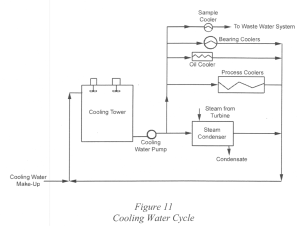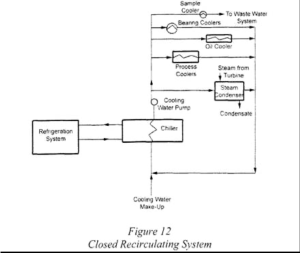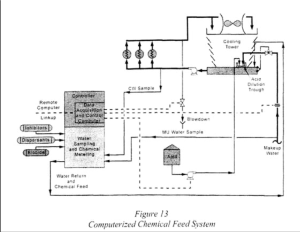Part 4: Cooling Water Systems
Cooling Water Systems

Cooling water systems can be open Circulating or closed Recirculating.
- The cooling water from the cooling tower basin is pumped to the plant heat exchangers.
- The heat exchangers include steam condensers, process coolers, bearing coolers, oil coolers and steam sample coolers.
- After the water has passed through the coolers and condenser, it is returned to the cooling tower where the heat it picked up in the coolers and condenser is released to the atmosphere.
- The water is cooled in two ways: by evaporative cooling, and by contact with the air.
- Hot water returns to the cooling tower are normally about 40°C to 45°C. The cooling water temperature from the cooling tower basin heading back to the plant is usually about 20°C.

In this system, the heat picked up in the various coolers and condenser is released in another type of cooler called a chiller.
The cooling medium can be ambient air, or it can be a refrigerant. The purity of the cooling water is easier to control because the water is not exposed to the atmosphere. No cooling water is lost to evaporation.
This means that little makeup or blowdown is required. The cost of the chemical treatment program is also low.
The disadvantage of ambient air as the cooling medium is the temperature of the cooling water is restricted by the temperature of the air. With refrigeration systems, the initial cost and operating costs of the system are higher.
Cooling System Operation
The cooling water system is started up before the rest of the plant processes and is shut down after the main processes no longer require cooling.
Water Supply and Blowdown
Operation of the cooling water system depends upon:
- A supply of fresh water- supply must be of low turbidity and as cool as possible.
- Ability to blowdown a small amount of the cooling water.- If the makeup water has been softened, less blowdown will be required.
Cooling Water Blowdown
Cooling water blowdown is et to control the concentration of the cooling water. Conductivity is often used to set the blowdown rate.
If limit is exceeded, scales of calcium and magnesium start to deposit in the heat exchangers.
Cooling Water Pumping
Operation of the cooling water systems depends upon the cooling water pumps to supply cooling water to the plants heat exchangers and back to the cooling tower.
Cooling water pumps normally take suction from the cooling tower basin. There are screens between the basin and the pump suctions.
The pumps are normally centrifugal and are used to supply a large volume of water at a low pressure (300-500 kPa). The pumps can be electrically driven or turbine driven.
When the main cooling water pumps are turbine driven, an electric driven pump is used for start up and pretreating the system, when steam is not available.
Pumps take water from the cooling tower basin. Balancing the cooling water flows through the cooling water heat exchangers can reduce the pumping horsepower of the pumps.
Cooling Tower Fans
Normally run at top speed to give the maximum amount of cooling. In winter, the fans can be slowed down or reversed to deice the cooling tower.
Chemical Feeding Equipment

Chemical feeding equipment is used to keep the chemistry of the cooling water under control.
Chemical feeding equipment is used to maintain:
-
- Cooling water pH,
- Cooling water chemical treatment,
- Biological control.
Cooling System Maintenance
Temperature difference across the heat exchangers (heat balance) is used to ascertain if the heat exchangers are fouled. This will indicate problems with a cooling system.
Includes:
- Cleaning out of the cooling tower basin
-
- Inspection and repair of the cooling tower wood structure and fill including the attachments of the structure to the cement foundation.
-
- Mechanical inspection and repairs to the fans, gearboxes and motors.
- Inspection of cooling water side of heat exchangers.
- Chemical tanks are cleaned out and pumping equipment repaired as required
Cooling System Startup
Steps in starting:
Step 1. Fill tower with fresh water and check the heat exchangers for leaks.
Step 2. Vent air from exchangers.
Step 3. When the cooling tower basin is at operating water level
-
- start a cooling water pump
- start circulating water through the system and back to the cooling water basin.
Step 4. Circulate water over the top of the cooling tower, wetting down the fill.
Step 5. Adjust the pH of the cooling water using acid or soda ash as required.
Step 6. When the pH is in the desired range for the treatment program, add the chemical treatment.
Step 7. Pretreat the system while circulating.
Step 8. Add chlorine or bromine for controlling microbiological activity in the cooling water.
Step 9. Accept heat load from the power plant or process.
Step 10. Start cooling tower fans to maintain the basin water temperature around 20°C.
Step 11. Take the normal water samples for laboratory analysis.
Cooling Water Chemistry
The type of treatment depends on the following factors:
-
- Type of cooling water system
- Volume and material present in the cooling water system
- Characteristics of the makeup water
- Quality of the cooling water and the number of cycles of concentration
- Maximum temperatures reached in the various parts of the system
- Flow velocities through the system
- Whether the cooling water on the shell side or the tube side of heat exchangers.
- Provision for blowdown
- Whether the cooling water system is operated continuously or intermittently.
Treatment involves preventing or removing the following:
Corrosion- Most common corrosion inhibitors are chromate-based inhibitors, polyphosphate-based inhibitors, and organic-based inhibitors.
Scale- These solids are mostly calcium and magnesium salts.
Antifoaming agents– Help control the amount of foaming in the cooling water.
Microbiological Fouling (Bacteria, Slime, and Algae)– Can be destroyed with biocides such as chlorine gas, sodium hypochlorite, and bromine.
Dissolved solids– Polyphosphates and polymers are added to the water to reduce the formation of scale in the system.
Ozone Treatment involves the use of an ozone generator. Ozone is injected into the cooling water and very quickly kills bacteria, slime and algae.
